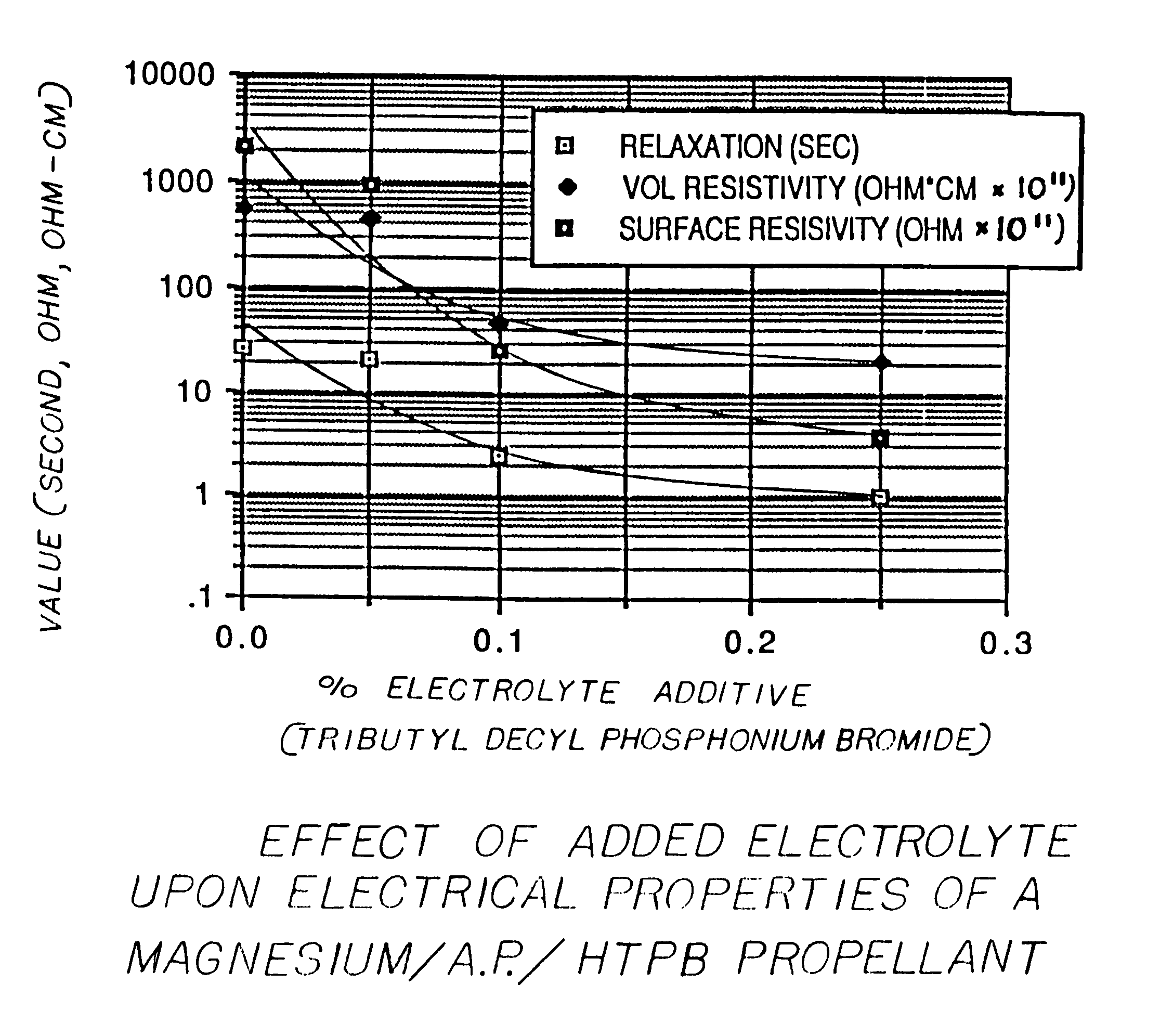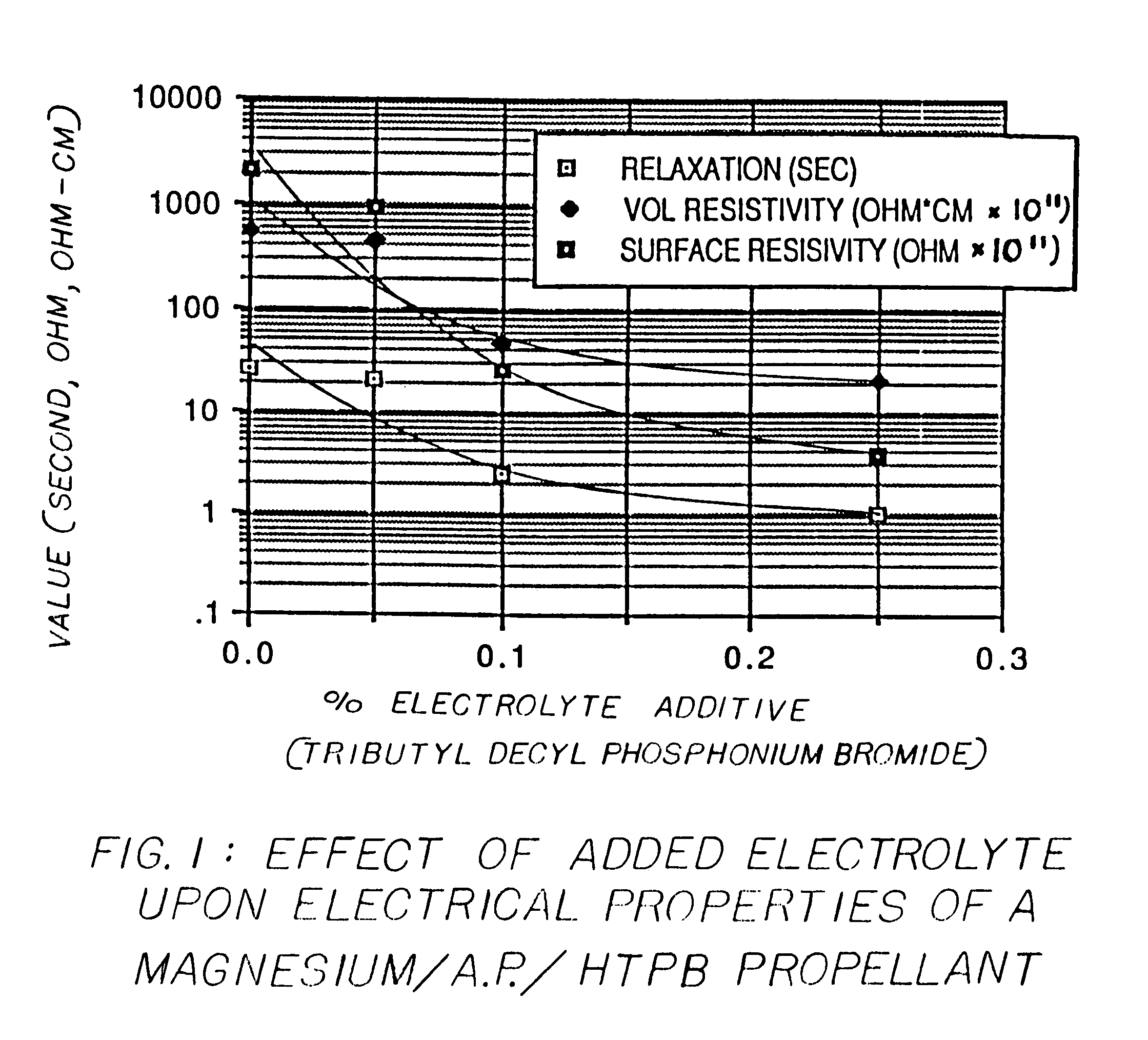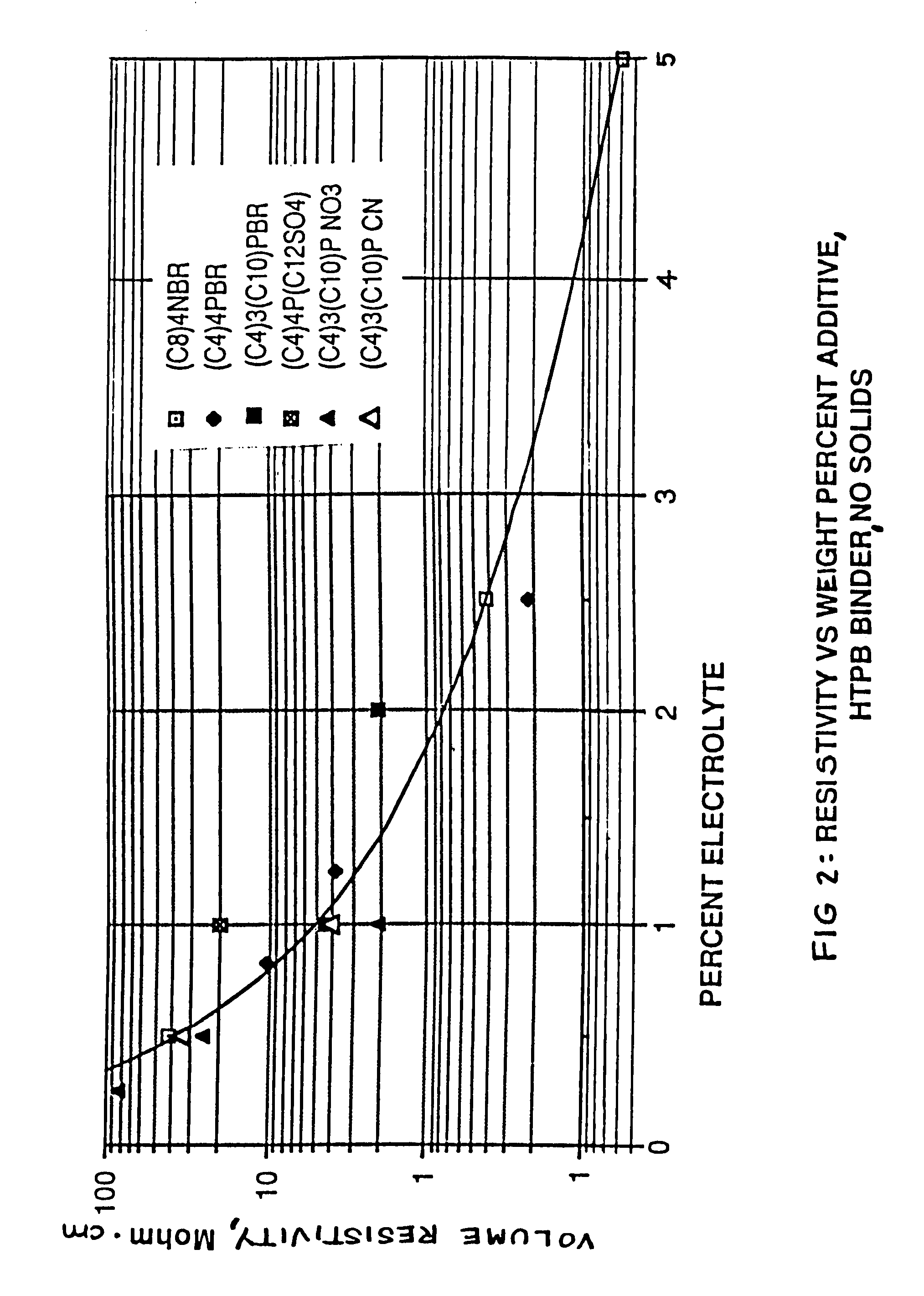Method for reducing charge retention properties of solid propellants
a technology of solid propellants and charge retention properties, which is applied in the field of solid propellants, can solve the problems of reducing the possibility of high potential electrostatic discharge and the general small additive upon combustion properties of the propellant, and achieves the effects of reducing electrical resistivity, significantly increasing conductivity, and reducing charge retention tim
- Summary
- Abstract
- Description
- Claims
- Application Information
AI Technical Summary
Benefits of technology
Problems solved by technology
Method used
Image
Examples
example 1
[0049]Propellant samples were prepared having the following composition:
[0050]
Total Solids87%Ammonium perchlorate68%Magnesium (powdered)19%Binder (HTPB)13%
[0051]In three comparative sample sets, one of the following quaternary salt was incorporated in the binder:[0052]a) tributyl decyl phosphonium bromide (TBDPB) at 0.05%[0053]b) tributyl decyl phosphonium bromide (TBDPB) at 0.1%[0054]c) tetra octyl ammonium bromide (TOAB) at 0.1%
[0055]Electrostatic tests were conducted on each sample at three different temperatures at 20% relative humidity. The results were as follows:
[0056]
VolumeSurfaceResis-Resis-tivitytivityDie-Relax.Tempohm-ohm-lectricTimeADDITIVEF.°cm × 1011cm × 1011Const.Seconds0.05% TBDPB −1821,400237,0005.91129.58 +714318985.320.23+13315.972.86.30.880.1% TBDPB −2010,40021,8005.9550.33 +7147.726.15.92.51+1284.838.075.30.230.1% TOAB −2280,40033,3005.64015.14 +71116046305.657.86+1231225615.96.44
[0057]The phosphonium salt was more effective than the ammonium salt for reducing t...
example 2
[0058]Samples of a standard HTPB / Magnesium / AP propellant were prepared. These samples included added electrolytes as follows:[0059](a) none (baseline samples)[0060](b) 0.25% tetrabutyl phosphonium dodecyl sulfate (TBPDS), and[0061](c) 0.25% tributyl decyl phosphonium bromide (TBDPB)
[0062]Electrostatic tests were conducted at 75° F. with the following results:
[0063]
ADDITIVENone0.25% TBPDS0.25% TBDPBVolume Resistivity5.6 × 1013 2.1 × 1013 0.21 × 1013ohm-cmSurface Resistivity22 × 10138.15 × 10130.039 × 1013ohm-cmDielectric Constant5.34.25.3Relaxation Time26.268.690.99Seconds
[0064]Both additives reduced the resistivity, but the additive (TBDPB) with unsymmetrical R groups was significantly more effective. Other tests conducted on these samples were as follows:
[0065]
ADDITIVENone0.25% TBPDS0.25% TBDPBEnd of Mix Viscosity, kP8.39.618.6Pot life (hour)4.56.06.0to 40 KPat 135° F.Hardness, Shore A826050Burning Rate at0.4950.4740.4531000 psi, inchesper secondBurning Rate0.410.410.40Exponent, n
[...
example 3
[0068]As illustrated in the table below, the burning rate as well as hardness and binder viscosity (measured at End of Mix EOM) are affected by the type and concentration of quaternary salt additive.
[0069]
TetraoctylAmmoniumTributyl DecylADDITIVENoneBromidePhosphonium BromideConcentration, %00.10.050.10.25Hardness, Shore A8281837350Burning Rate at0.4950.4960.4920.4870.4531000 psi, inchesper secondViscosity, EOM, kP8.017.016.018.019.0
[0070]Thus, the ballistic, mechanical and processing property effects must be considered in selecting the particular electrolyte additive and its concentration.
[0071]The ideal additive will be one which is a liquid, and produces the desired conductivity increase at a low concentration, with no or minimal change in specific impulse, hardness, and viscosity, and without introducing undesirable chemical species into the propellant.
[0072]At concentrations between about 0.02 and 0.25 percent by weight of propellant, the indicated phosphonium salts are very eff...
PUM
| Property | Measurement | Unit |
|---|---|---|
| temperature | aaaaa | aaaaa |
| temperatures | aaaaa | aaaaa |
| electrostatic charge retention | aaaaa | aaaaa |
Abstract
Description
Claims
Application Information
 Login to View More
Login to View More - R&D
- Intellectual Property
- Life Sciences
- Materials
- Tech Scout
- Unparalleled Data Quality
- Higher Quality Content
- 60% Fewer Hallucinations
Browse by: Latest US Patents, China's latest patents, Technical Efficacy Thesaurus, Application Domain, Technology Topic, Popular Technical Reports.
© 2025 PatSnap. All rights reserved.Legal|Privacy policy|Modern Slavery Act Transparency Statement|Sitemap|About US| Contact US: help@patsnap.com



